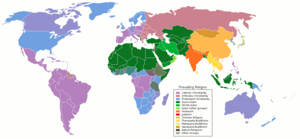Sect
| Part of a series on |
| Discrimination |
|---|
 |

A sect is a subgroup of a religious, political, or philosophical belief system, usually an offshoot of a larger group. Although the term was originally a classification for religious separated groups, it can now refer to any organization that breaks away from a larger one to follow a different set of rules and principles. Sects are usually created due to perception of heresy by the subgroup and/or the larger group.
In an Indian context, sect refers to an organized tradition.[1]
Etymology[]

The word sect comes from the Latin noun secta (a feminine form of a variant past participle of the verb sequi, to follow[2]), meaning "a way, road", and figuratively a (prescribed) way, mode, or manner, and hence metonymously, a discipline or school of thought as defined by a set of methods and doctrines. The present gamut of meanings of sect has been influenced by confusion with the homonymous (but etymologically unrelated) Latin word secta (the feminine form of the past participle of the verb secare, to cut).[2]
Sociological definitions and descriptions[]
There are several different sociological definitions and descriptions for the term.[3] Among the first to define them were Max Weber and Ernst Troeltsch (1912).[3] In the church-sect typology they are described as newly formed religious groups that form to protest elements of their parent religion (generally a denomination). Their motivation tends to be situated in accusations of apostasy or heresy in the parent denomination; they are often decrying liberal trends in denominational development and advocating a return to true religion. The American sociologists Rodney Stark and William Sims Bainbridge assert that "sects claim to be authentic purged, refurbished version of the faith from which they split".[4] They further assert that sects have, in contrast to churches, a high degree of tension with the surrounding society.[5] Other sociologists of religion such as Fred Kniss have asserted that sectarianism is best described with regard to what a sect is in tension with. Some religious groups exist in tension only with co-religious groups of different ethnicities, or exist in tension with the whole of society rather than the church which the sect originated from.[6]
Sectarianism is sometimes defined in the sociology of religion as a worldview that emphasizes the unique legitimacy of believers' creed and practices and that heightens tension with the larger society by engaging in boundary-maintaining practices.[7]
The English sociologist Roy Wallis[8] argues that a sect is characterized by "epistemological authoritarianism": sects possess some authoritative locus for the legitimate attribution of heresy. According to Wallis, "sects lay a claim to possess unique and privileged access to the truth or salvation" and "their committed adherents typically regard all those outside the confines of the collectivity as 'in error'". He contrasts this with a cult that he described as characterized by "epistemological individualism" by which he means that "the cult has no clear locus of final authority beyond the individual member."[9][10]
In other languages[]
The corresponding words for "sect" in European languages other than English ��� Sekte (German), secte (French), secta (Spanish, Catalan), sectă (Romanian), setta (Italian), seita (Portuguese, Galician), sekta (Polish, Czech, Slovak, Bosnian, Croatian, Serbian, Slovenian, Latvian, Lithuanian), sekt (Danish, Estonian, Norwegian, Swedish), sekte (Dutch), szekta (Hungarian), секта (Russian, Serbian, Bulgarian, Ukrainian), σέχτα (Greek) – refer to a harmful religious sect and translate into English as "cult".[citation needed] In France, since the 1970s, secte has a specific meaning[which?] which is very different from the English word.[11][need quotation to verify]
In Buddhism[]

The Macmillan Encyclopedia of Religion distinguishes three types of classification of Buddhism, separated into "Movements", "Nikāyas" and "Doctrinal schools":
- Schools:
- Theravada, primarily in South Asia and Southeast Asia;
- Mahāyāna, primarily in East Asia;
- Vajrayāna, primarily in Tibet, Bhutan, Nepal, India, Mongolia and the Russian republic of Kalmykia.
- Nikāyas, or monastic fraternities, three of which survive at the present day:
- Theravāda, in Southeast Asia and South Asia;
- Dharmaguptaka, in China, Korea and Vietnam;
- Mūlasarvāstivāda, in the Tibetan tradition;
In Christianity[]
While the historical usage of the term "sect" in Christendom has had pejorative connotations, referring to a group or movement with heretical beliefs or practices that deviate from those of groups considered orthodox,[12][13] its primary meaning is to indicate a community which has separated itself from the larger body from which its members came.
Orthodox[]
Roman Catholic sects[]
There are many groups outside the Roman Catholic Church which regard themselves as Catholic, such as the Community of the Lady of All Nations, the Palmarian Catholic Church, the Philippine Independent Church, the Brazilian Catholic Apostolic Church, the Movement for the Restoration of the Ten Commandments of God, Most Holy Family Monastery, and others.
Protestant sects[]
In Hinduism[]

The Indologist Axel Michaels writes in his book about Hinduism that in an Indian context the word "sect does not denote a split or excluded community, but rather an organized tradition, usually established by founder with ascetic practices."[1] According to Michaels, "Indian sects do not focus on heresy, since the lack of a center or a compulsory center makes this impossible – instead, the focus is on adherents and followers."[1]
In Islam[]
The ancient schools of fiqh or sharia in Islam are known as "madhhabs." In the beginning Islam was classically divided into two major sects. These divisions are well known as Sunni Islam and Shia Islam. Kharijite and Murijite Islam were two early Islamic sects. Each sect developed several distinct jurisprudence systems reflecting their own understanding of the Islamic law during the course of the history of Islam.
Current sects[]
Sunnis are separated into five sub-sects, namely, Hanafi, Maliki, Shafi'i, Hanbali and Ẓāhirī.
The Shia, on the other hand, first developed Kaysanism, which in turn divided into three major groupings known as Fivers, Seveners and Twelvers. The Zaydis separated first. The non-Zaydis are initially called as "Rafida Groups." These Rafidis were later divided into two sub-groups known as Imamiyyah and Batiniyyah.[14]
- The "Imami-Shi'a" later brought into existence Ja'fari jurisprudence. Akhbarism, Usulism, and Shaykhism were all ensued as variations of "Ja'fari fiqh," while Alawites and Alevis who are not the strict followers of "Ja'farism" are developed separately from the teachings of Ithna'ashari Imāms.

- Batiniyya groups, on the other hand, were divided into two sub-groups known as Seveners and Ismā'īlīs. Qarmatians who did not follow the Fatimid Caliphate were branched from the Seveners. Those groups of Batiniyya who followed the Fatimids are the ancestors of today's Ismā'īlīs. Druze was emerged as an offshoot of Ismāʿīlism at the beginning of the 11th Century. Isma'ilism at the end of the 11th Century split into two major branches known as Nizārī Ismā'īlī (Assassins of Alamut) and Musta’li Ismaili. As a result of the assassination of Fatimid Caliph Al-Amir bi-Ahkami'l-Lah, Mustaali was once more again divided into Hafizis and Taiyabi Ismailis (Dawoodis, Sulaymanis and Alavis).
- The Hanafi, Maliki, Shafi'i and Hanbali Sunnis, the Twelver groups, the Ismā'īlī groups, the Zaydis, the Ibadis, and the Ẓāhirīs continue to exist. In addition, new sects like Black Muslim movements, Quranists, Salafis, Wahhabis, and Zikris have been emerged independently.
Former sects[]
- The Khawarij were initially divided into five major branches: Sufris, Azariqa, Najdat, Adjarites and Ibadis.
Amman Message[]
An Islamic convention held in Jordan in July 2005, which brought 200 Muslim scholars from over 50 countries together, announced the official recognition of eight schools of Islamic jurisprudence[15] and the varying schools of Islamic theology.[16] The eight recognized Islamic schools and branches are:
- Sunni Hanafi
- Sunni Maliki
- Sunni Shafi'i
- Sunni Hanbali
- Shi'i Imāmī (followers of the Ja'fari jurisprudence)
- Shi'i Zaydi
- Khariji Ibadi
- Sunni Ẓāhirī
In Jainism[]
See also[]
- Classifications of religious movements
- Cult (religious practice)
- New religious movement
- One true church
- Religious exclusivism
References[]
- ^ Jump up to: a b c Michaels, Axel (2004). Hinduism past and Present (2004) translated from German "Der Hinduismus" (1998). Princeton University Press. ISBN 0-691-08952-3.
- ^ Jump up to: a b
"sect (n.)". Online Etymology Dictionary. Douglas Harper. Retrieved 2018-11-03.
mid-14c., "distinctive system of beliefs or observances; party or school within a religion," from Old French secte, sete "sect, religious community," or directly from Late Latin secta "religious group, sect in philosophy or religion," from Latin secta "manner, mode, following, school of thought," literally "a way, road, beaten path," from fem. of sectus, variant past participle of sequi "follow," from PIE root *sekw- (1) "to follow." Confused in this sense with Latin secta, fem. past participle of secare "to cut" (from PIE root *sek- "to cut"). Meaning "separately organized religious body" is recorded from 1570s.
- ^ Jump up to: a b McCormick Maaga, Mary excerpt from her book Hearing the Voices of Jonestown (Syracuse: Syracuse University Press, 1998) available online
- ^ Stark, Rodney, and Williams Sims Bainbridge (1979) Of Churches, Sects, and Cults: Preliminary Concepts for a Theory of Religious Movements Journal for the Scientific Study of Religion 18, no 2: 117–33
- ^ Stark, Rodney, and William Sims Bainbridge (1985) The Future of Religion: Secularization, Revival, and Cult formation Berkeley and Los Angeles: University of California Press
- ^ Kniss, Fred, and Numrich, Paul (2007) Sacred Assemblies and Civic EngagementRutgers University Press
- ^ McGuire, Meredith B. "Religion: the Social Context" fifth edition (2002) ISBN 0-534-54126-7 page 338
- ^ Barker, E. New Religious Movements: A Practical Introduction (1990), Bernan Press, ISBN 0-11-340927-3
- ^ Wallis, Roy The Road to Total Freedom A Sociological analysis of Scientology (1976) available online (bad scan) Archived 2008-04-05 at the Wayback Machine
- ^ Wallis, Roy Scientology: Therapeutic Cult to Religious Sect abstract only (1975)
- ^ Esquerre Arnaud, "Lutter contre les sectes: l’invention d’un psycho-pouvoir", Le Banquet, n°24, février 2007, p. 199-212
- ^ Wilson, Bryan Religion in Sociological Perspective 1982, ISBN 0-19-826664-2 Oxford University Press page 89
"In English, it is a term that designates a religiously separated group, but in its historical usage in Christendom it carried a distinctly pejorative connotation. A sect was a movement committed to heretical beliefs and often to ritual acts and practices like isolation that departed from orthodox religious procedures." - ^ Herbermann, Charles, ed. (1913). . Catholic Encyclopedia. New York: Robert Appleton Company.
- ^ Ahmed Cevdet Pasha, Kısas-ı Enbiyâ, vol. II, page 12.
- ^ The Amman Message summary – Official website
- ^ The Three Points of The Amman Message V.1
External links[]
| Look up sect in Wiktionary, the free dictionary. |
| Wikiquote has quotations related to: Sect |
- Church sect theory by William H. Swatos, Jr . in the Encyclopedia of Religion and Society by Swatos (editor)
- Apologetics Index: research resources on cults, sects, and related issues. The publisher operates from an evangelical Christian point of view, but the site links to and presents a variety of viewpoints.
- ReligionNewsBlog.com Current news articles about religious cults, sects, and related issues.
- Sects
- Sociology of religion
